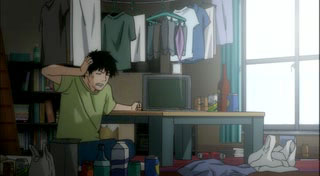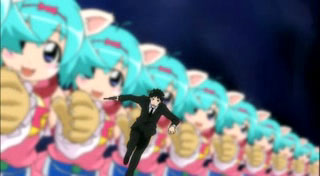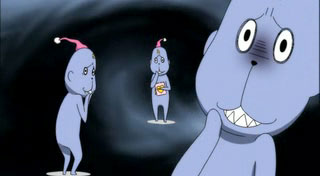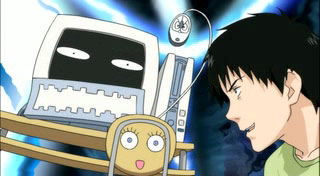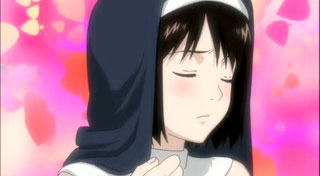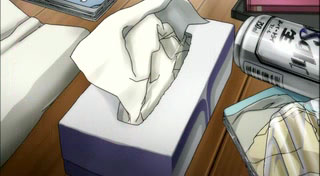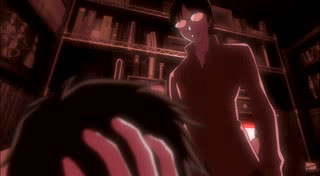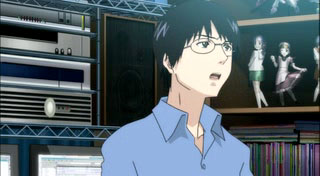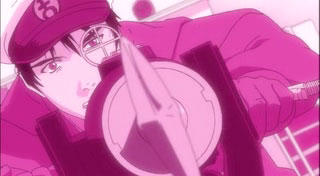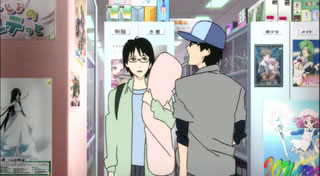 Logo handmade by Bannister
Column by Scott Green
Logo handmade by Bannister
Column by Scott Green
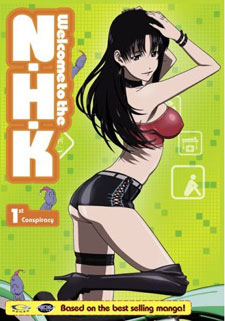
Anime Spotlight: Welcome to the NHK Volume 1 Released by ADV Films
If Neil LaBute wrote about anime geeks, the results would be something like Welcome to the NHK. Its hero is self obsessed, self delusional. He's not even a figure of pity, the anime itself is actively aggravated with its protagonist and what he represents. Stewing alone in his one room apartment, Welcome to the NHK's 22 year NEET (not in employment, education or training) protagonist Sato postulates that 99 percent of all conspiracies are false inventions, created to deflect personal responsibility. However, he's also certain that he has stumbled onto a factual plot. Japan's PBS-ish Nippon Hoso Kyokai (Japan Broadcasting Corporation) is in fact the Nihon Hikikomori Kyokai: a malignant influence constructed to shatter the ability to deal with other human beings within Japan's youth. In a bout of cabin fever madness, he sees a vision of himself as a secret agent, rushing across ice fields under an aurora of singing cartoon faces, ready to bomb the laughing manifestation of this outlet of anime. As a paint peeling acidic provocation, Welcome to the NHK goes in a direction that is frequently shied away from an anime and particularly televised anime: refusal to pander. It's a proponent of the school of thought that geeks are not misunderstood or misjudged. Instead, like most people, they are unpleasant and selfish, except they have the extra charms of poor interpersonal skills and an addiction to escapism. Welcome to the NHK is reputedly a savage comedy. And it is regularly funny, in the way that hitting yourself on the humerus bone is funny. Which is to say, it is grimace inducing. The money shot of the jokes are Sato's outrageous reactions to any sort of stimuli. He tries to climb up the social ladder, and spectacularly trips downward after enthusiastically leaping toward any vice, whether it is pornography online video games, or some other fantasy.Tatsuhiko Takimoto's Welcome to the NHK novel was expanded into an eight volume manga series with Kendi Oiwa, which was in turn adapted into a 24 episode anime series by Gonzo. Like Gonzo's work on Speed Grapher. The Welcome to the NHK anime is missing the control of a confident director who would ensure a level of consistent output throughout the anime. Even during the course of the first four episodes, well conceived scenes brush against poorly executed ones, and consequently, what's on screen often has less potency than the potential of the explored idea, with animation that frustratingly pushes against convention, but falls to inconsistent quality. Like paid dating or suicide pacts were, and like the declining birthrate is, shut-ins or "hikikomori" (literally, "confined") generate a Japanese cultural awareness ranging from interest to apocalyptic social concern. The issue of people who will not work, attend school or contribute to society, so called NEETs frequently becomes conflated with "otaku" excessively obsessive geeks. To be accurate, these are overlapping sets rather than a unified block. Not all hikikomori are otaku and not all otaku are hikikomori. However, while a wide gap exists between someone who entirely withdraws from society versus a functioning job holder/student, the sharp difference in degrees does not entirely preclude the two from being discussed in the same breath. To speculate without the backing of sociological rigor, there does appear to be a germ of the hikikomori withdrawal in the fascination with virtual worlds or intense interest/obsession that generally marks otaku. Despite being advised against it, due to the negative native connotations of the word, North American anime fans have long called themselves "otaku", and in Japan, the pendulum of public opinion has swung in favor of the "otaku" since the 1989 Tsutomu Miyazaki shaded its general reception. More recently, it has become a marketing paradigm. Rather than just the anime/manga/video game fan with shelves of figures, there is a "hiking otaku" that you could sell gear to or a "fashion otaku" that you could sell special interest magazines to. However, even if the acceptance is promoted and the definition is broadened, it's still a notion of people defining themselves by their interest in physical or virtual object. As attention to the notion of a socially withdrawn hikikomori gained attention, it took on a life of its own in media as a character type. Japanese Foreign Minister and almost Prime Minister Taro Aso is notoriously a fan of PEACH-PIT's Rozen Maiden, a manga, then anime about a hikikomori teenager who refuses to attend school and burdens his harried older sister/caretaker until he becomes entangled in a conflict between living dolls. In the recent comedy Sayonara Zetsubou Sensei (Farewell Mr Despair), there is a joke that introduces a catch phrase into the anime. Pathologically cheery school girl Kafuka Fura (Franz Kafka) is informed that her neighbor is a" hikikomori". Kafuka denies the possibility that this girl, who has chained herself into her room, is a hikikomori and proclaims, "how could a hikikomori, something I've only seen on TV or in the newspaper exist so close to me?" Instead, Kafuka Fura insists the girl is a zashiki-warashi or supernatural house-spirit. Both in media targeted for the geek audience and works with broader public appeal, the otaku life style is justified and the hikikomori is presented as a fixable condition. In the former case, there are works like Genshiken, which does for anime/manga (and the ancillaries: video games, cosploy, plastic models and such) what Cheers does for bar patronage. In nerd terms, with plenty of exposition, it stages the time spent in these endeavors as a comfortable, acceptable release from other troubles. Then, in the case of the hikikomori, there is the "true story" of Densha Otoko/Train Man, in which BBS 2channel played Cyrano to an isolated geek who found true love when he told off a drunken harasser that was badgering female passengers on a train. Where Genshiken is complementary to otaku and where as Train Man is a cloying fairytale that reassures the general public that the people that seem to be following off the social landscape are only a hair cut and wardrobe upgrade away from functional members of society, Welcome to the NHK is the Requiem for a Dream of geek obsession and insecurity. There's a hackney line about how a drug habit is cheaper than an anime addiction. That might absolutely false, but Welcome to the NHK makes a convince case for the danger of locking out the real work in favor of virtual ones. It caustically confronts the notion that a loser can find someone who will love them unconditionally, and that the love of this good soul can repair the loser. Instead, it suggests that like a drug abuser who has cooked their neural chemistry, a person who spends years avoiding social contact can reach a point where they have permanently rewired themselves. Rather than pratfalls and romantic rivals, in this relationship anime, the fulcrum point is the hero's astounding failure in the face of opportunity. This figure isn't coddled for his potential to become a functioning member of society or respected for his individuality, sensitivity and inner strength. If the American Rom Com standard of pushing the issue of an over extended adolescence got nasty, it would be something like Welcome to the NHK. This might sound like an act of geek self loathing, and to a large extent it is, but the condemnation is more general. The barb of the work, and the reason why Sato can't be written off is that his troubles are a contradiction to the theory of self correction. "Tomorrow, I'll start my diet." "Tomorrow, I'll start learning that new skill." You pull your hair out watching this character, because in order to improve his dead end existence, he really just needs to get up, find any brand of employment, and follow through. If he was sweeping flours, he'd be doing infinitely better. Yet, we know from our own lives, that overcoming inertia sounds simple, but rarely is. The woes of a geek who can't get out of his own way, who can't get his act together is simply an extreme example of a more universal concern. On his way to a college class, Sato Tatsuhiro suffered a panic attack in which he envisioned all the anonymous faces of the urban crowd laughing at him. The event sent him back to his apartment, which he's haunted ever since. Now at age 22, he's spent years living as a vampire, never leaving except to creep out to the convenience store after dark, sustained by sucking off the funds sent by his parents. He sleeps. He smokes. He drinks. He thumbs through men's magazines. Finally, losing touch with reality from the lack of mental stimulation, and from the nauseatingly saccharine anime theme song looping as it pipes through the wall separating his apartment from his neighbor's, he decides the years of hermitage are equivalent to a warrior's pilgrimage, and that, now, he should be able to chop through a beer bottle with his hand. The anime is effective in capturing Sato's mindset. It covers the cabin fever of his apartment, in which the walls seem to be closing in and mental voices begin reverberating be his head. Secondly, it excels capturing the process of self-justification. The script and pacing put together paths by which someone like Sato can explain their actions to themselves. There's always some egotistical metaphor or imagined chain of events that provides a reason for being where he wants to go, or doing what he wants to do. As Sato is bandaging his hand, something happens that is more unexpected than a destitute failure injuring himself. His doorbell rings and he finds himself face to face with human beings. Specifically, there is a middle aged religious evangelical ready to proselytized and decry the dangers of hikikomori, and her teenage niece looking angelic beneath a parasol. Bleeding, confronted by something that challenges his boxed off world, Sato wildly gesticulates and insists that he is in no way a hikikomori. Later, he meets the girl again, and again lies to her. The third time they run into each other he learns that her name is Misaki, and that her new project is to fix him. Welcome to the NHK's humor is based on the shock of Sato's self degradation. The comic irony is that this is a person who guards how he presents himself so closely that's shut out the outside world, becoming literally ridiculous in the process. The problem that the anime has version of the title has is that it neither exaggerates the behavior to the breaking point (like the manga) or tries to pass it off as a function of the laws of real psychology (like the novel). Instead, it becomes shtick. The anime evidently puts aside any notion of a naturalistic presentation. Sato performs to the back row with his broad gestures. In the manga, it is possible to regard over-committed imagery as a short hand for the experience. Here, Sato leans to berate, turns to make asides; mawkishly recites obvious lies and screams. Put into motion, the full out expressiveness is comparable to overacting, and the consequence of the not dialing down the all-crazed mode of the manga is that Sato registers as an anime character and not a credible person. Another issue stemming from the beer bottle chop is that the anime is often degrees safer than other incarnations of Welcome to the NHK. It's like the televised version of Fist of the North Star in which bloody sprays are colored white. (Or the various color schemes of the blood in the original home console versions of Mortal Combat). The intent is still there, but it is evidently tamed. The Welcome to the NHK anime has booze, smoking and porn, but through the first four episodes, omitted drugs. To get to this point in the novel or manga, Sato was injecting dicey semi-legal substances. The line between stir crazy and drug fueled stir crazy shades the anime such that Sato comes across as a bit wackier and less damaged. And, the anime swims clear of the deep end in the legal water of parody by not implicating specific, real people and properties. Nadia (she of the The Secret of Blue Water) is no longer indicted as the vanguard of the NHK. Generic boulder splitting anime rather than Kyokushinkai and Masutatsu Oyama is the inspiration for attacking the bottle. What is ironic is that though 17/18 year old Misaki is older than all of those 13/14 year old anime principals, it is her youthfulness that is emphasized. Framed by a parasol, or reading shoujo manga, that puppy dog cuteness feeds into the otaku impulse to fantasize females within the moe framework: here's an innocent angel come to fall in love with a troubled man. Since no woman can fit into the ideal, the moe fascination is a retreat into fantasy and virtual girls rather than real women. As soon as Misaki explicitly present her idea to fix Sato, this pattern is upset in that Misaki's influence is defining Sato rather than the inverse. To the anime's credit, for the most part, it does not rail against how male viewers relate to anime female, then present its own characters in the same light. Sato and Misaki are both playing roles in this anime, and the presentation accentuates that. Misaki might be more graceful than Sato's extreme manners, but while Sato is explosively flailing, Misaki is still swaying, pointing her hips out and mugging. Yet, apart from the excruciatingly unironic covers, with the sexualized, near naked Misaki on volume two even worse than this volume's, the anime rarely partakes in the sort of pigeon holing of female personalities that it indicts. Readers of the manga and novel know to expect that the relationship between Misaki and Sato will become more complex than her simply pushing him, but even the mere act of the character actively challenging the lead, telling him that he is a mess, is ignorantly more inflammatory than anime's conventional relationships. But, it does need to strain credulity a bit to push events along, given that Sato makes a lethal impression. Misaki's dedication to Sato in the face of his repeated denials and outrageous lies registers as a fictional contrivance. But, that actually helps matters. There's no possibility that she sees something redeemable, and as such, he's the one being objectified. It's not Sato: The Damaged Heart, it's Hikkokmori: The Project. And here is where Welcome to the NHK's trademark pessimism comes in. Prompted to step out into the world, Sato commences scrambling toward any outlet for escape. Initially he's a hikikomori, who drinks, smokes, in other versions of the story, abuses other drugs, and generally protects his isolated stasis by sleeping 16 hours a day. After opening his door to outside influences, his malaise is replaced by manic otaku obsession. The chief demiurge in this transformation is the neighbor who had been looping the maddening anime theme. Of Welcome to the NHK's various incarnations, the anime is the one that attentively organizes Sato's influences. Before Misaki enters Sato's life, the anime flashes back to Sato's high school days, which followed the pattern of Sato wasting days zoning out in school, blowing off his berating class representative Hitomi and wasting afternoons playing solitaire while Hitomi, an older girl from the school's literary club, spouted conspiracy theories and fished for personal validation. The chief, memorable exception to this routine was the day that Sato tried to impress Hitomi by stepping in to protect a bullied middle school student. The incident resulted in Sato being left on the ground bleeding, but it earned him the admiration of the younger Yamazaki. As soon as the anime commences, the re-entrance of this trio of characters is a forgone conclusion. So, when Sato finally decides to hammer on the door of his noisy neighbor, and finds Yamazaki weeping in front of a computer screen, the reunion is unsurprising. And its through Yamazaki that Sato is introduced to online pornography, dating simulation PC games in which the girls both comfort the player and remove their clothes, maid cafe's in which the stuff wear revealing fetish costumes, and shopping trips to Akihabara, where one can purchase character figures with removable clothes. In one of Gonzo's interludes of unconventional animation techniques, Sato is pictured fishing the internet see for racy photos. And Sato dives into this world with a dedication that he could never muster hunting for work or pursing a healthy relationship. The whole otaku endeavor, from production to consumption, is cast in a terrible light. Every one of the seven deadly sins is well represented. While appreciating otaku media, Sato and Yamazaki fantasize about subservient girls and horde porn. When they try their hand at creating, it's even worse. They try their hand making their own "gal game," which they half expect to be a sellable, profitable project. This languishes in the planning phase, in which the pair iterates through all the existing conventions, generating a fictional love interest who is a childhood friend, maid, robot, lover from a past life, fox spirit... Even taken as an exaggerated parody, the combination of misogyny and absence of creativity in Sato and Yamazaki's project is fiery indictment of popular trends in anime. Again, the anime break these jokes by overdoing them. As these scenes are expanded to fit the 25 episode format, crudlity is stretched. Sato falling for a game character that reminds him of a more subservent version of Misaki is in keeping with his character. Gooing "I'm her big brother?!?" to the openning scene of a dating game is difficult to accept. His "there's porn on the internet?!?" reaction, and deleting his computer's opperating system to make room for more really breaks the character in the attempts to create humor. It's series like Welcome to the NHK that earned Gonzo's animation teams a reputation for outstanding promise and unfortunate failure. This project gives a stage to fascinating animators, such as Masashi Ishihama and Hisashi Mori (Samurai 7, episode 7). And evidently, it gave them some space to work. A famous scene of talking appliances stands out for its wackiness, but other instances where the perspective is fractured really take the opportunity to break the static, conventional ways of moving figures. Doing so requires fluidity, flexibility and a willingness to bend the model. Unfortunately, Welcome to the NHK is missing a watch dog to keep the all sequences corralled, regardless of whether they feature a giant giggling NHK gremlin or a sitting figure. Especially given that the objective of the anime is often to evoke a mood, the animation does not simply get into trouble through its use of short cuts, though it does animate minimalistically when possible. There's a scene of Sato in high school that features him in the literary club room. The scene is simply composed of minimal character movement, specific late afternoon lighting and a slow pan. That scene is perfectly judged. Alternatively, situating a still, off model figure in the foreground for the duration of a conversation seems misjudged. Scenes like the latter look like weak links in a collaborative process. It's probably not entirely fair to point a finger at director Yusuke Yamamoto. Gonzo does leave themselves open to speculation that their procedures foster these results. However, the failing of Welcome to the NHK's animation is a lack of a consistent authoritative voice that would ensure that, even if segments expressed creative indivuality, all the pieces effectively fit together.
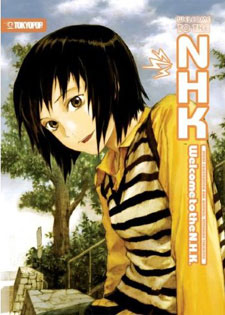
Pros Spotlight: Welcome to the NHK (Novel) by Tatsuhiko Takimoto Cover by Yoshitoshi ABe Released by TOKYOPOP
The Welcome to the NHK novel is best read before starting the anime/manga or after completing either/both. Its direct approach to the subject's crawl over a field of broken glass, toward maturity and stability, and its suggestion, then rejection of a reductionist unpinning to the Sato/Misaki relationship sharply contrasts the other versions' role as elongated comedies. However, even it is a charged approach to a charged subject, the novel is ultimately a light read that takes an afternoon at most to complete. Only by comparison can the work, in any way, be thought of as gritty social realism. Its greatest accomplishment is that it succinctly attacks the hikkomori lifestyle and easy remedies, while credibly aging the characters beyond the point at which they were initially introduced. Fans of the Welcome to the NHK anime and manga might be surprised to find a straight forward arc in place of the dark convolutions the carry the works that the novel inspired. Working with the dictates of a novel rather than a serialized manga or weekly anime series, events move more naturally. People move in and out of the narrative of their own accord or because their routines simply don't match Sato's. Initially, Misaki has a lighter influence as Yamazaki drives Sato into a single otaku nosedive. Later, it's Yamazaki's turn to fade out as the Sato/Misaki dynamic comes into focus. There's even a period where Sato finds work and lives a dreary, self destructive life, unattached to otaku passions, and arguably better off than the hikkomiri existence. The novel does not court the role of outrageous comedy, and as a consequence, the moments in which the characters demonstrate their flaws are that much darker. The novel features more drinking and drugs than other versions of the story. While he does not expand on the subject to the same length that Yamazaki talks anime women, Sato does explain the drugs he injects and their effects, Given the brevity of the entire work, their role becomes even more pronounced. And, comparatively, they're given a more truthful, less showy role. In place of visions of dancing appliances, this incarnation presents more typical expressions of drug abuse, such as fighting and creating a public nuisance. There's also frightening depravity and it is apparent how the manga projected some of the extreme situations and how the anime reined that in. Though it is a Yamazaki inspired exercise, it's intensified when Sato goes on a porn binge with light prompting. Though he doesn't exactly funnel the internet like he did in the anime, his search does take a painfully dicey turn, and for a moment, the novel suggests Sato's near evolution into the kind of nightmarish otaku that society rightly fears. Though Misaki's early presence is minimized, the novel is driven by an examination of how that initial meeting set up Sato's long progression. There are a number of humorous set pieces, but the novel does not dedicate itself to mining for jokes. While there are a number of grin-worthy situations, most of the light moments play as "you had to be there" anecdotes... "remember the time we got buzzed and went to the park to beat the hell out of each other..." "remember the time we took the uppers and walked into the church meeting..." In fact, few of the humorous scenes involve sobriety. Because it is not driven by comedy, the novel lacks most of the superfluous meandering and journey of geek humiliation. The various concerns with Sato's parents are mentioned, but the individuals themselves never appear. Megumi Kobayashi is similarly absent of the proceedings. Hitomi is more of an echo of the past than a siren pulling Sato towards more malfeasance. Yamazaki sends Sato down one trajectory, rather than an odyssey of geek excess. They have their voice in the proceedings, and in either case, it is one of people who have not grown up or reconciled with the needs of society. Hitomi articulates dissatisfaction with mundane troubles and Yamazaki, at length, articulates the otaku lust for virtual worlds. In either case, the novel captures self destructive people on the verge of, not so much burning out, as calming down with age. Using the strengths of the prose medium, the novel excels at getting into the heads of these characters. Sato narrates, explains and gives characters, Yamazaki specifically, enough rope to hang themselves with this point of view. From Sato's understanding, both the mystery and reality of Misaki's role is explored. One of the novel's interesting tricks is to suggest that a jun-ai/pure love bond developing between the pair, than mediate that with a more naturalistic truth. Even if Misaki is not as explicit about her motivations as other characters, there is a discernable logic to her involvement with Sato. To a larger extend than other versions; Misaki is an average girl with some notable hang-ups rather than a moe cuety. When the novel takes an initiative and illustrates that she's not a divine, magical girlfriend or a crazy stalker, the fresh quirk on the character is that she's a voracious book reader. One of the book's best jokes, and one which contributes to explaining her MO, is when she reaches out to Sato with real 101 level philosophy and psychology. The practical extension of her innocence is expressed in this superficial level of knowledge and experience. Because of her age, the novel does not establish a meeting between a geek and a real woman, but, between the pair, the novel constructs a unique, often morbidly tinged, meeting of the minds.
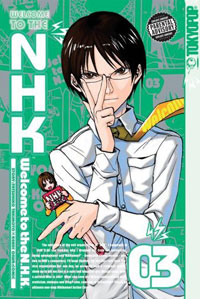
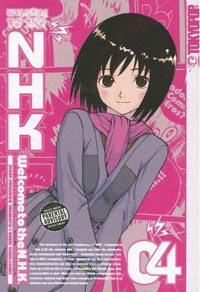
Manga Spotlight: Welcome to the NHK Volumes 3 and 4 by Kendi Oiwa Released by TOKYOPOP
If there's a version of Welcome to the the NHK that's a real pitch black comedy, it's the manga. Unlike the anime, there is an unrestricted zeal to the catalogued debasement. Unlike the novel, the manga demonstrates pleasure in provoking this level of discomfort. There's a theory that consuming horror is an act of masochism. The genre follower knows they will connect to a character then vicariously suffer with that imagined person. As a comedy of discomfort, Welcome to the NHK operates on a similar principle. Sato fouls opportunities harshly and frequently. In this version, his inaction and avoidance is compounded by his string of blunders. He leaps onto activities that he shouldn't. He blows off people he shouldn't. The only thing worse than his decisions is his imagination. Though he's only avoiding responsibility and thinking dirty thoughts, as the manga chugs through situations, he becomes more and more despicable. If you are a geek, or you associate with geeks, then the real cruelty of this manga cuts through. For the most part, these are familiar blunders. And again, the intension is not simply to pile on geeks. Sato walks the reader into a pessimistic world view, where he's far from only one drawn to the falseness of easy solutions and escapes. Throughout volume 3, Sato's empty wallet leads him through a series of psyche pounding set pieces. The principle at work is that at age 22, Sato needs to stop living a parasite life. A scheme to sell virtual objects farmed from massive multiplayer role playing games (MMMORPG's) is just about the worst enterprise for a shut in with a tenuous grasp on reality to jump into. South Park was recognized with an Emmy for its savaging of World of Warcraft, but, the activity came off lightly next to this savaging of the MMORPG's false validation. From the stand-point of comparing how free time is spent, players are not generally logged into the game in lieu of practicing differential equations or reading Tolstoy. So in a sense, the games aren't an inherently more destructive activity than watching sports or playing poker. Except, as Sato demonstrates: a) they're a time sink that prompts players to ignore life b) players are in danger of walking into relationships, assuming that what's on screen reflect reality. Even with secondhand knowledge of MMORPGs, this isn't revelational insight. Yet, Welcome to the NHK turns this an amazingly ugly exercise. Sato becomes so hooked on the gratification offered by these games, he turns himself into one of those lab rats trained to select a dose of cocaine rather than food. On the other end of the spectrum, Farrelly Brother comedy have nothing off the discomfort of Misaki debasing herself to catch Sato's attention as he melts into game play. This isn't exactly a subtle discussion of the role of MMORPGs in geek isolation. The suggestion that a geek with an MMORPG is going find to himself unshaven, malnourished and further alienated might only be a few degrees shy of the PSA that proposed if a teenager smokes spot, they'll be living on the street within five years. Yet, it's the sledgehammer comedy that earned Welcome to the NHK its reputation. It's engaging in that the showy ferocity is provocative. The second half of the volume concerns the introduction of Megumi Kobayashi and the world of garbage enterprise. Her trajectory has been the inverse of its Sato's. His insanity in in doing nothing and expecting his lot to improve. Hers is in driving her head into the wall and expecting results. Where he has developed into a flea, she has become a vulture; Since her days has a highschool class representative, she's been desperate to get ahead in the world, and it's been a cheap route paved by putting one over on people; generally otaku. Out of school, she made money selling jewelry while catching the attention of otaku in a cosplay outfit. Since then, she's graduated to pyramid schemes. This character is Welcome to the NHK's jaw cracking uppercut. She wasn't part of the original novel and doesn't fit into the obvious hikkikomori liberation narrative. Instead, she's the blow you weren't watching out for: a person, who, in theory, should have their act together. She's a worker, who, again in theory, has adapted to her opportunities. It's faith shattering to see her weep in a bathroom stall then use sales jujitsu to ruin some sucker. While situations like her Ponzi scheme sales meeting run right up to the line of outright farcical, this segment of Welcome to the NHK feature's the work's social gallows humor at its finest. Volume four begins to complicate the Sato/Misaki relationship. It shreds the simplicity and the notion of Misaki as an ideal girl. In doing so, the manga is bound to become more devise. That's not because it drives home the certainty that she’s her own person, whose existence does not serve the purpose of being a girlfriend. It's impossible to reach this point without realizing you're not getting Oh My Goddess or one of its descendants. Gender politics aren't going to be what causes readers to become fascinated with the shifting direction or reject it. It's that once the story starts exploring the motivations that a girl like Misaki might have for reaching out to a guy like Sato, the manga no longer stands as a dissection of what's wrong with people like Sato, Yamazaki, Hitomi Kashiwa and Megumi Kobayashi. If you want control over your life you can get to the point of shutting yourself into a room to block out the world. If you want control over your relationships you can get to the point of writing pandering dating games. If you want control over your finances you can get to the point of bilking others. If you want SOMETHING, you can get to the point of deciding to fix a hopeless geek. Here's where the manga gets engrossing or aggravating. Misaki's needs and motivations are brought into question. Not only are they not spelled out, she goes out of her way to lead false breadcrumb trails. The Densha Otoko promise becomes a fractured fairytale. Even if it's not as simple as Misaki turning Fatal Attraction, the whole relationship angle becomes re-spun as a brittle give-and-take between two individuals with very pronounced needs and expectations.

